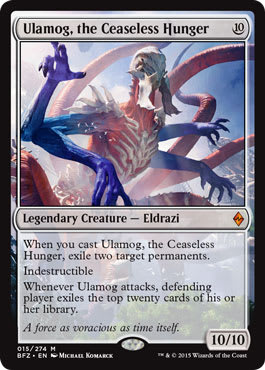Standard is about to get shaken up in a big way, and not just because Aether Revolt is entering the format. This week, we saw the largest set of bannings since Arcbound Ravager was in Standard, and the cards defined several of the top tier strategies in the format are no longer available. That’s going to leave players scrambling to do one of three things: find a deck untouched by the bannings, find cards that can replace the banned cards, or find ways to adapt strategies so they can better function in the new Standard. If you’re looking for a place to start, consider Daiho2000’s take on Blue-Red Eldrazi:
Blue-Red Eldrazi- Kaladesh Standard | Daiho2000, 5-0 Standard League|
- Creatures (10)
- 1 Ulamog, the Ceaseless Hunger
- 2 Drowner of Hope
- 2 Elder Deep-Fiend
- 2 Torrential Gearhulk
- 3 Weaver of Lightning
- Planeswalkers (2)
- 1 Chandra, Torch of Defiance
- 1 Jace, Unraveler of Secrets
- Instants (19)
- 1 Flame Lash
- 1 Negate
- 2 Scatter to the Winds
- 2 Spell Shrivel
- 3 Glimmer of Genius
- 3 Kozilek's Return
- 3 Spatial Contortion
- 4 Harnessed Lightning
- Artifacts (3)
- 3 Hedron Archive
- Lands (26)
- 5 Island
- 1 Sanctum of Ugin
- 1 Spawning Bed
- 3 Mountain
- 4 Aether Hub
- 4 Shrine of the Forsaken Gods
- 4 Spirebluff Canal
- 4 Wandering Fumarole
- Sideboard (14)
- 1 Negate
- 1 Prophet of Distortion
- 1 Spatial Contortion
- 1 Sphinx of the Final Word
- 1 Weaver of Lightning
- 2 Ceremonious Rejection
- 2 Reality Smasher
- 2 Summary Dismissal
- 3 Thought-Knot Seer
This is a great deck for a number of reasons. It was a surprise contender for one of the better decks in the format at the end of the previous Standard format, using the likes of Mage-Ring Network to power out giant threats while leaving up countermagic. This deck has picked up a number of new and exciting tools with Kaladesh, and this build is also completely untouched by the B&R announcement.
On its surface, this is a relatively traditional Torrential Gearhulk control deck. You’ve got a handful of counterspells backed up by Harnessed Lightning, Glimmer of Genius, and the Gearhulk itself. The key difference is this: rather than playing a greedy three-color mana base, this deck opts for a more conservative, two-color setup. The reason for this is to afford to play the two cards Hedron Archive and Shrine of the Forsaken Gods. Playing largely spells with single-colored requirements lets you play Hedron Archive and Shrine of the Forsaken Gods to ramp into giant monsters, but without giving up your ability to leave up interaction early on.
The benefit? Getting to play the likes of Drowner of Hope, Elder Deep-Fiend, and Ulamog, the Ceaseless Hunger at the top end of your curve. These cards give you the ability to turn the corner and start beating down and closing out games much more sharply than other Torrential Gearhulk decks, which is a huge boon in a format with as many haymakers at the top of the curve as this one.























